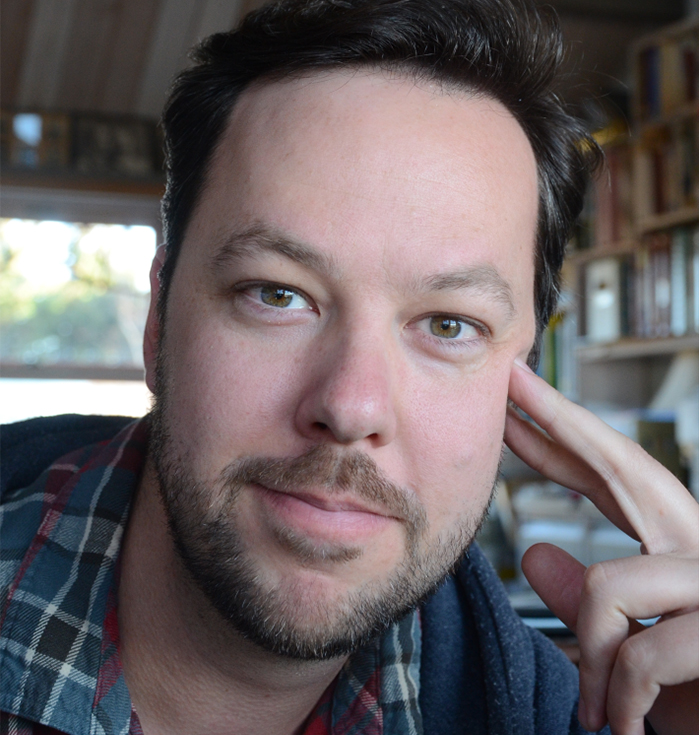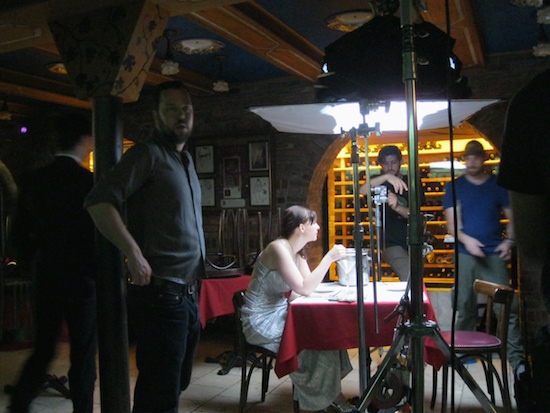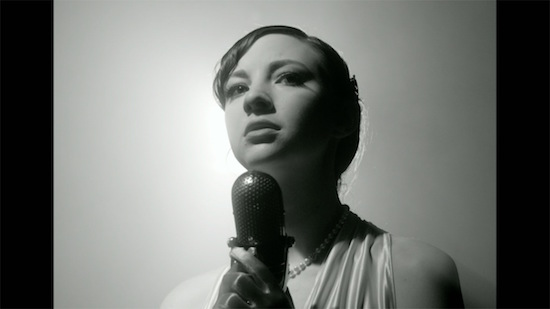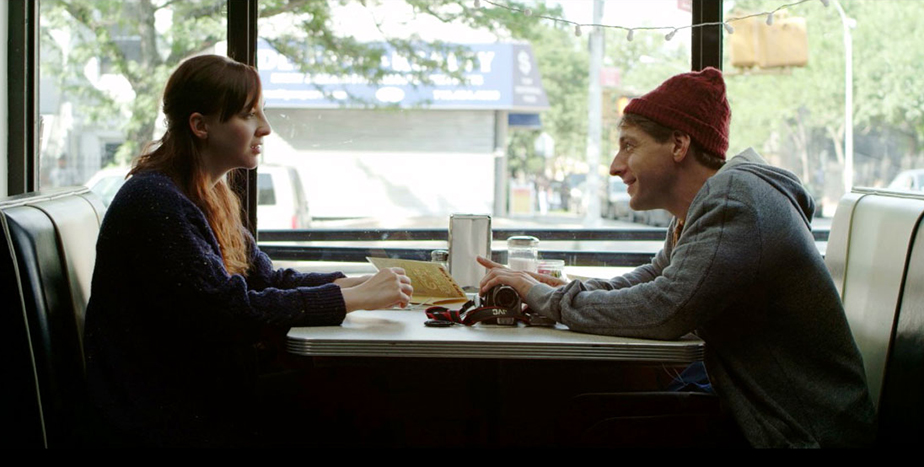Danny Peary Talks To… ‘Seven Lovers’ Director Keith Boynton
(from DansPapers.com
LAURA AND IAN IN KEITH BOYNTON'S "SEVEN LOVERS," NOW STREAMING
SEPTEMBER 21, 2017 BY DANNY PEARY
A couple of years ago I spent a fun afternoon doing a set visit—at a restaurant in Little Italy—on the last day of shooting for Keith Boynton’s independent feature Seven Lovers.
From the press notes’ synopsis: “Laura is young librarian/former singer trying to navigate the endless complexities of love, lust, and dating in contemporary New York. In a fractured kaleidoscope of genre and emotion, we watch seven of Laura’s romances play out in a series of interwoven vignettes—with each of her lovers laying claim to a very specific cinematic style.”
I was hoping this one-of-a-kind film by the son of famous illustrator Sandra Boynton and the late Jaime McEwan, the legendary Olympic slalom canoeist, would have a quick release. I was eager for audiences to see the long-awaited new feature by the innovative writer-director, and the first starring role by Erin Darke, who’d made a big splash in the small role of a naughty librarian in Kill Your Darlings. Unfortunately, like many independent films, after playing in festivals it took a while before it became widely available. Now, finally, it can be seen on Amazon, iTunes and other outlets.
The trailer:
Seven Lovers is an incredibly ambitious endeavor for Boynton. His seven different “styles” include animation, POV and sketches of Darke’s Laura. He even wrote the music. And Darke, who is rarely not on screen and is often the only person in the frame, had the opportunity to showcase her remarkable versatility by playing Laura in seven different ways without losing sight of who she is at the core. She proved to be as adept at doing screwball comedy as intense drama.
Just as the director and actress faced challenges making their film, viewers will be challenged to determine how Boynton utilizes various styles to express themes; figure out the identities of the Laura’s seven lovers (one is always behind a camera, one we never see, one is animated); and put Laura’s fractured two-year story into chronological order so they can understand her rocky journey from heartbreak to happiness. It may take more than one viewing!
This week, Keith Boynton and I had the following conversation.

Keith Boynton, Photo: Beverly Hall
Danny Peary: I became a fan of your filmmaking from watching your clever shorts, including those you made in record time. You made them available online but they were definitely festival worthy. At the time you were making them, were you thinking of them as stepping stones to making feature films?
Keith Boynton: Yes and no. Technically, I had already made a few features at that point, but they were extremely amateurish—more like learning experiences than polished works that were ready for an audience. When I did the “12 Films in 12 Weeks” project you are referring to, I think I was eager to do my learning on a smaller scale, with lower stakes. That was also a great way to meet new people and build up a body of work. Chasing Home was the feature that grew out of that process. It was made only a year later, with a lot of the same people, and on a similarly rigid timetable–we had only four weeks to write, shoot, and edit the whole movie. Kind of insane, but it worked!
DP: I thought Chasing Home was too low-key to be commercial, but I was very impressed by it. It came across that the director was self-assured. Did it get any distribution or recognition?
KB: Well, thanks! I’m really proud of that movie. It played at a couple of festivals, and was well received there, but it didn’t have much of a life beyond that. People can watch it on Vimeo, if they’re interested! I think anyone with siblings will find it especially resonant.
DP: Before and between making movies, you were writing plays, from serious dramas to farces. When writing them—and acting in them—did you always think that you would like to film them?
KB: Never! People have occasionally told me that a particular play would make a good movie (or vice versa), but for me each piece exists firmly in the medium it was imagined for, and it’s very hard for me to see it taking any other form.
DP: After Chasing Home, you made a lot of music videos. I really like the one you did for an Alison Krauss song and the one with indie favorite Jess Weixler. Were you just biding your time between films or were you learning the craft?
KB: The music-video thing basically came about by accident. I was casually acquainted with the members of the indie folk-rock band the Spring Standards, and they needed a video, and the stars aligned. When I realized it was something I enjoyed and could do well, I started hounding my friends in the group Darlingside about doing a video with them, and after that people started approaching me with projects. This all came at a really good time, because I was in the midst of getting my MFA at Columbia, and didn’t really have time to work on a feature. Music videos were the perfect outlet. I should mention that my dear friend Mike Lavoie was heavily involved in all of the above-mentioned projects; 12 Films in 12 Weeks, Chasing Home, and the music videos were all things that we undertook together, as a kind of dynamic duo. Mike also plays the gay bartender in Seven Lovers, so even though he didn’t produce that movie, he’s a part of it, too.

On the set: Keith Boynton standing in the shadows, Erin Darke in the spotlight for a tense 1930-ish black-and-white sequence, Photo: Danny Peary
DP: Do you still make music videos?
KB: I do! I just completed one for my mother Sandra Boynton’s new children’s album, Hog Wild, and I’m in talks with Darlingside to do an animated video for their upcoming album.
DP: Could you have written and directed Seven Lovers, an ambitious and risky film, without having had the experience of making an earlier feature?
KB: Maybe, but it would have been terrible. It took me a long, long time to develop a feel for what makes a movie work: how a scene is built out of shots, how a story is built out of scenes. I made my first movie in 2003, and I wouldn’t show it to anyone now for all the tea in China.
DP: If I concluded that you came up with the idea of filming Seven Lovers in seven different styles—a different one for each of Laura’s lovers—because you thought you’d never get the chance to make seven films in different genres, would I be totally wrong?
KB: “Totally wrong” seems a little harsh—but the truth is, I’ve always assumed I would make all kinds of films, in all kinds of different genres, in the course of a long and prosperous career. Maybe that’s naïve, or arrogant, or both, but it’s kind of a nice assumption to operate under. It remains to be seen how it will all pan out!
DP: Were you tempted to add words to your title so that viewers would understand there was intention behind your changing styles throughout the film—and that there is a different style for each lover—and you weren’t just a schizophrenic amateur? So the title might be something like Seven Lovers, Seven Styles and viewers would know from the beginning what you were trying to do and you would not risk confusing them?
KB: No, I have a lot of faith in the audience. Part of the fun of the film is that it unspools gradually; at first it seems kind of scattered, then you start to track the individual stories, and eventually you build up a picture of the larger story they all add up to. It’s a bit like a puzzle that assembles itself as you go.
DP: Talk about the audition process in finding someone to play Laura. Why did you choose Erin Darke?
KB: She made the choice pretty easy. We had a bunch of wonderful actresses come in and read for Laura, and we reached out to some big names as well, but it soon became obvious that Erin embodied the soul of the character—and had the versatility needed to depict Laura in seven (well, six) different styles. Anne Bogart describes working with a great actor as similar to driving a top-notch racecar; you push the pedal, and it just goes. I guess it’s a weird analogy, but it makes sense to me.
DP: Erin told me when I visited your set that when you first discussed Laura she wanted to talk to you about the differences in Laura in the seven scenarios, which made sense to me because I find it hard to believe that the sophisticated nightclub singer who has a romance with Dan is the same person as the screwy librarian who is tongue-tied and does pratfalls around the handsome Brit Ian. But you wanted to talk to her about the similarities in the character in all the scenarios because Erin would infuse herself into whoever she was playing.
KB: It was a pretty hilarious moment when we realized we were approaching that question from completely opposite angles. I think in part, it just came down to the difference between a director’s mindset and an actor’s; I’m trying to make sure I bring each of the seven styles into vivid, specific life, and she’s trying to make sure her character has a consistent psychology. In the end, though, she was right, and I was wrong. The stylistic stuff is obvious, especially for an actress as gifted as Erin; Laura’s inner life is less immediately apparent—and ultimately more important.
DP: Were you looking for an actress who understood Laura from reading the script or an actress who could take an unformed character and give her full-body life?
KB: Both, and I think the same could be said of any character. No character, no matter how well-written, is alive on the page the same way they’re alive when an actor is steps in and starts inhabiting them. A great actor gives you what you wrote, but exponentially more vibrant and nuanced. It’s one of the joys of my job.
DP: Men in the film call Laura “baffling,” and “a mystery.” Did you fully understand Laura or had you written a character who you wanted to be a mystery even to you?
KB: I felt like I understood her, but I’m not sure I could ever have explained her. In some ways, it’s like real life; the people we know best are often the people we’re least able to describe or define. Knowing someone is a feeling, not a formula. Laura makes sense to me intuitively—but don’t ask me why.
DP: In your film, Laura is said to be a “million people” to different people. Yet she calls herself “a quick study,” which she is certainly not because she is so unpredictable. Is your film in part about the positive growth of a woman who underestimates herself in significant ways?
KB: Well, anyone who’s at all empathetic has the experience of adapting to different people and their different needs. That’s not a bad thing—in fact, it kind of makes relationships possible—but there is the risk that you lose yourself in the process. I think Laura knows who she is on a fundamental level, but sometimes she needs reminding—which I suspect is true of most of us.
DP: I think some men are turned on by her looks, her deep feelings, her—again—mystery—her quirkiness, even her craziness. What is her allure to you?
KB: Her vulnerability and her idealism. I think there’s something inspiring about a person who can take a few punches and bounce back up still smiling, still open, still curious and basically optimistic. Laura goes through the wringer in the course of this movie, but she doesn’t let herself become cynical, and I think that’s a pretty major victory in itself.
DP: Do you think it is essential for viewers to fall in love with Laura?
KB: I think it’s possible to enjoy the movie without loving Laura—and some people have described having that experience—but I’d much prefer to have people love her, because I love her, and I think the film is richer that way.
DP: How essential was it for Erin to fully trust you?
KB: I’m not sure she did! Erin’s much too intelligent to have complete trust in a stranger, which I was at the beginning of this project. I’d say it was essential for her to give me the benefit of the doubt, which she did. Hopefully she doesn’t regret it!
DP: Well, she told me that she did trust you! From your viewpoint, how difficult was her performance? I know your film was rushed so I am amazed that she even was able to memorize all those lines and deliver them flawlessly to a director who loves long takes.
KB: I don’t know how difficult it was for Erin, because she’s a genius. I know she worked really hard, and I know she made my job 10 times easier by always being prepared and brilliant. I think it would have been possible to make the movie with another actress, but it’s not something I’d be eager to attempt.

Laura (Erin Darke) sings
DP: As Laura in the black and white thirties-musical sequences with Dan, Erin has to sing and dance. Was that part of her audition?
KB: It was not! We basically just asked her if she could sing and dance, and she said “kind of,” and that was good enough for us. It helped that Max von Essen, who plays Dan, is a Broadway star and a consummate song-and-dance man. Erin was especially nervous about the singing, but in the end she did it beautifully—with a few tweaks in post-production, of course.
DP: When you saw La La Land, were you thinking how your dance sequence in the gazebo came first?
KB: I was slightly disheartened when I saw the poster with Emma Stone and Ryan Gosling dancing, actually, because it was so clear they were drawing on the same ultra-romantic Golden Age musicals that inspired the Dan segments in Seven Lovers. At the end of the day, though, they’re very different movies, and I think there’s room in the world for both of them—which I’m sure Damien Chazelle will be very relieved to hear.
DP: Was that your favorite sequence to film?

Laura and Brian in “Seven Lovers”
KB: It was pretty magical. Dusk falling in Central Park, the rain letting up just in time to let us shoot, the lights of the city coming on across the water … it was definitely a highlight. It was also our first day back after a family crisis took me away from the set, and that made it all the more special, and kind of healing.
DP: The music in your movie is quite evocative. Were the lyrics to the songs written specifically for Laura?
KB: They were! I wrote the lyrics for each song as I reached its place in the story, and I tried to make them encapsulate Laura’s dilemma at that moment. Since Laura’s various love stories move in parallel with each other—first meeting, first kiss, first argument, and so on—the songs are able to speak pretty specifically to where she is emotionally at a given moment in all seven stories.
DP: There is a long scene in which an uncomfortable Laura strips for her lover Karl as he films her and they have an awkward conversation. Was that a hard scene for you to film?
KB: To a degree. I’m pretty uncomfortable with stuff like that—but, once again, Erin made it easy. She was a total pro about the whole thing, and very ready to laugh at the awkwardness of it all—which really, really helped.
DP: If Laura had met Karl before she had her heart broken, would she have recognized him for being a stalker and not be seduced by his attention to her, and his calling her “fascinating”?
KB: I think so, yeah. I think Karl happens to meet her at a very vulnerable moment, and, consciously or not, he exploits that. One of the joys of writing the script was gradually discovering those connections—how each relationship leads into the next one. It’s not very explicit in the completed film, but it’s there if you look closely enough.
DP: Laura has two meet-cute moments, with handsome Brit Ian (Peter Mark Kendall) in the library and awkward blind date Brian (Fran Kranz) on the street. She meets them around the same time, so were you worried that viewers might come to favor the wrong lover of the two for Laura to end up with? I confess I might have picked the other guy for her. Or even the sketch artist Dominic, the character you voice but we never see, who probably knows her best.
KB: Well, I want people to be at least a little conflicted. There’s certainly more than one suitor who seems like a credible option, and maybe there’s more than one Laura could be happy with. Dominic seems like a really good guy, but the fact that we never see his face doesn’t bode well for him. People like faces.
DP: Does Laura realize she is going through a process of pushing her bad romances aside and finding true love? Or could she end up alone and be happy?
KB: I think when you come to grips with all your past traumas and disappointments, there’s always the hope that you’re clearing the deck for something wonderful and new. Could Laura be happy alone? Probably, yeah. But isn’t it more fun to be happy with someone else?
Seven Lovers movie poster
DP: Could Laura have had a healthy relationship two years before?
KB: Yes, but I’m not sure she would have fully appreciated it. When you know how easily things can go wrong, I think it means more when they finally go right.
DP: Laura really seems to like eating! What’s that all about?
KB: It wasn’t conscious, but I think I drew this detail from my youngest sister Darcy, who has a lot in common with Laura, including being delightful and exuberant and kind of a goofball. The eating thing is also reminiscent of Gilmore Girls, which—perhaps not coincidentally—is one of Darcy’s favorite shows.
DP: Talk about your inspiration for the long-take diner scenes with Laura and Brian.
KB: People like Robert Altman and Woody Allen—people who let the camera roll and let the actors talk. In the case of Seven Lovers, those scenes weren’t improvised, but they do have kind of an improvised flavor. There’s also a great long two-shot in Keeping the Faith [2000, directed by Edward Norton], which you might not notice because it feels so organic. That’s the challenge with any long take, whether it’s moving or static: can we make this feel so natural that people don’t even realize how long the shot is? If the average audience member thinks “Wow, they haven’t cut in a while,” you’re definitely in trouble.
DP: When Laura looks at herself in the mirror, what does she see?
KB: Hope, I think. Wary, wounded hope.
DP: Without giving away the end, if she looked at herself in the mirror again then, what would she see?
KB: Hopefully contentment. Self-acceptance. Wouldn’t that be nice?
DP: Could you have put your footage together in chronological order, or is it essential for us to learn about her past at appropriate times?
KB: I think the cross-cutting is important, because it helps us feel like the story is moving forward, even though each relationship is kind of a self-contained story in itself. It also gives us a lot of things to guess about: Which of these stories comes first? Which comes last? How does each relationship set the stage for the next? I think that element of mystery is part of what keeps us engaged.
DP: Erin told me that she hated filming to end because it was such a fun set. Were you having fun, too, or was the film so ambitious that you couldn’t relax?
KB: It’s a testament to my producer, Mélisa Breiner-Sanders, that I was able to enjoy myself most of the time. She did a phenomenal job of looking after the logistics of production, so that I could focus on telling the story. There were certainly some stressful moments, but for the most part I had a ball. And I’m glad to hear Erin did too!
DP: How can people see Seven Lovers?
KB: People can just close their eyes and try to picture it as vividly as they can ….Or they can see it on Amazon! iTunes! Comcast! Google Play! Vudu! And probably others I’m forgetting!
Danny Peary has published 25 books on film and sports, including Cult Movies and Jackie Robinson in Quotes.
No comments:
Post a Comment